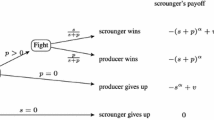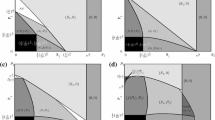Abstract
Kleptoparasitism is the stealing of food by one animal from another. This has been modelled in various ways before, but all previous models have only allowed contests between two individuals. We investigate a model of kleptoparasitism where individuals are allowed to fight in groups of more than two, as often occurs in real populations. We find the equilibrium distribution of the population amongst various behavioural states, conditional upon the strategies played and environmental parameters, and then find evolutionarily stable challenging strategies. We find that there is always at least one ESS, but sometimes there are two or more, and discuss the circumstances when particular ESSs occur, and when there are likely to be multiple ESSs.
Similar content being viewed by others
References
Barnard, C. J., & Sibly, R. M. (1981). Producers and scroungers: a general model and its application to captive flocks of house sparrows. Anim. Behav., 29, 543–555.
Brockmann, H. J., & Barnard, C. J. (1979). Kleptoparasitism in birds. Anim. Behav., 27, 487–514.
Broom, M., & Ruxton, G. D. (1998). Evolutionarily stable stealing: game theory applied to kleptoparasitism. Behav. Ecol., 9, 397–403.
Broom, M., & Ruxton, G. D. (2003). Evolutionarily stable kleptoparasitism: consequences of different prey types. Behav. Ecol., 14, 23–33.
Broom, M., Luther, R. M., & Ruxton, G. D. (2004). Resistance is useless?—extensions to the game theory of kleptoparasitism. Bull. Math. Biol., 66, 1645–1658.
Broom, M., & Rychtář, J. (2007). The evolution of a kleptoparasitic system under adaptive dynamics. J. Math. Biol., 54, 151–177.
Grimm, M. P., & Klinge, M. (1996). Pike and some aspects of its dependence on vegetation. In J. F. Craig (Ed.) Pike: biology and exploitation (pp. 125–126). London: Chapman and Hall.
Holling, C. S. (1959). Some characteristics of simple types of predation and parasitism. Can. Entomol., 91, 385–398.
Jeanne, R. L. (1972). Social biology of the nootropical wasp. Bull. Museum Comp. Zool., 144, 63-1-50.
Kruuk, H. (1972). The spotted hyena: a study of predation and social behaviour. Chicago: University of Chicago Press.
Luther, R. M., & Broom, M. (2004). Rapid convergence to an equilibrium state in kleptoparasitic populations. J. Math. Biol., 48, 325–339.
Luther, R. M., Broom, M., & Ruxton, G. D. (2007). Is food worth fighting for? ESS’s in mixed populations of kleptoparasites and foragers. Bull. Math. Biol. 69, 1121–1146.
Maynard Smith, J. (1982). Evolution and the theory of games. Cambridge: Cambridge University Press.
Rothschild, M., & Clay, T. (1952). Fleas, Flukes and Cuckoos. Glasgow: Collins.
Ruxton, G. D., & Broom, M. (1999). Evolution of kleptoparasitism as a war of attrition. J. Evol. Biol., 12, 755–759.
Ruxton, G. D., & Moody, A. L. (1997). The ideal free distribution with kleptoparasitism. J. Theoret. Biol., 186, 449–458.
Shealer, D. A., & Spendelow, J. A. (2002). Individual foraging strategies of kleptoparasitic Roseate Terns. Waterbirds, 25, 436–441.
Spear, L. B., Howell, S. N. G., Oedekoven, C. S., Legay, D., & Bried, J. (1999). Kleptoparasitism by brown skuas on albatrosses and giant-petrels in the Indian Ocean. The Auk, 116, 545–548.
Steele, W. K., & Hockey, P. A. R. (1995). Factors influencing rate and success of intraspecific kleptoparasitism among kelp gulls. The Auk, 112, 847–859.
Stillman, R. A., Goss-Custard, J. D., & Caldow, R. W. G. (1997). Modelling interference from basic foraging behaviour. J. Anim. Ecol., 66, 692–703.
Triplet, P., Stillman, R. A., & Goss-Custard, J. D. (1999). Prey abundance and the strength of interference in a foraging sea-bird. J. Anim. Ecol., 68, 254–265.
Author information
Authors and Affiliations
Corresponding author
Additional information
The research was supported by the EPSRC grant EP/E043402/1 and the NSF grant 0634182.
Rights and permissions
About this article
Cite this article
Broom, M., Rychtář, J. Kleptoparasitic Melees—Modelling Food Stealing Featuring Contests with Multiple Individuals. Bull Math Biol 73, 683–699 (2011). https://doi.org/10.1007/s11538-010-9546-z
Received:
Accepted:
Published:
Issue Date:
DOI: https://doi.org/10.1007/s11538-010-9546-z




